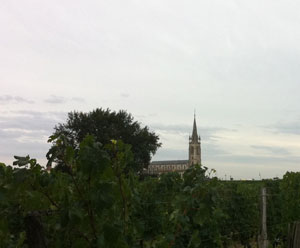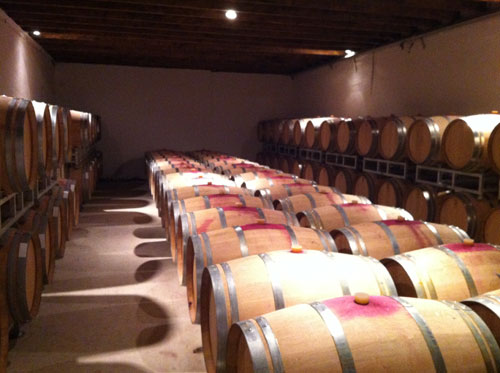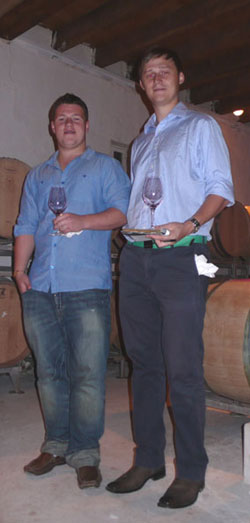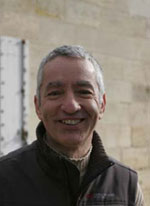Last Sunday Ben and I went to visit Denis Durantou in Pomerol at his home, Château L’Eglise Clinet. As mentioned in my previous blog, I have a great fondness for his wines, due to the skill of wine making, and the freshness that all his wines have. We met Denis outside in the vineyard and we went walking through the vines as he was deciding whether it was time to pick the Merlot. This was a great chance to learn from a Pomerol master. The previous week he had picked the grapes for his ‘Les Cruzelles’ label from the younger vines.

The Church of Pomerol seen through the vines at Eglise Clinet
|
We tasted some of the grapes in the Eglise Clinet vineyards, and Denis explained to us the analytical process that goes into deciding the right time to harvest. Firstly, it is necessary to check the grapes from at least five vines in the vineyard to get a proper representation. Denis takes three grapes at a time, removes the pips so as to avoid the bitterness affecting the taste, yet counting the pips per grape in order to judge the tannic potential. Denis is also checking for the colour of the skins and whether they will colour the wine well. Finally in tasting he is looking for the right balance to create his wines. Having made this analysis, he tells us that he will begin to pick the Merlot the next day, the same day as we are at Latour.
After walking through the vineyards we visited the tasting room where Denis kindly offered us a few wines to try. We started with the 2009 Montlandrie from Castillon, bottled 4 months ago. The wine is 75% Merlot and 25% Cabernet Franc. It is as I remember it from tasting at Farr Vintners a few weeks before: ruby/purple in colour, fresh, with crisp acidity and good length. There is a nice balance of fruit and spice, and certainly this is one to start drinking in a year or two’s time, a very nice start to the day. The terroir of this Château is similar to that of Troplong Mondot and other vineyards in St Emilion, and the combination of the soils and Denis’ skill as a winemaker make this a very attractive wine. Amazingly, despite the same terroir, the vineyard that Denis bought in Castillon cost a fraction of the price of those in St Emilion.

The barrel Cellar at Eglise Clinet
|
We took a big step up by tasting the 2010 Eglise Clinet from barrel next. This wine is as great as I remember it from the En Primeur tastings this Easter. What a wine! The nose is densely packed with layers of spice, florality, brooding dark fruit and something almost flinty. The palate is big and bold, but not at all hot. The wine is fresh, with a grippy, tannic structure at this young age, and a nice acidity. The finish is long, very long. What strikes me about this wine is how each characteristic is clearly defined, the fruit, spice and floral aspects are beautifully wrapped in layers that level over each other to make a very complex but perfectly balanced wine. This is still one of my wines of the vintage. I feel my mouth stretch as a broad smile is drawn across my face, and I manage to muster the words ‘it’s really great’ as I taste. My words don’t do the wine justice, Ben and I are both in awe of the quality.

Ben and Thomas at Eglise Clinet
|
Though it may seem odd, we tasted Petite Eglise 2010 after Eglise Clinet. This 100% Merlot wine, made from vines on more gravelly soil is instantly distinct from its bigger brother. The wine is fresh and floral on the nose, but more supple and rounded on the palate. The wine certainly has good structure for ageing, and has great length, but it is more approachable even at this stage. The wine again has a great balance of tannin and acidity, though it is less austere at this point, and is very moreish. Denis tells us as we taste the wine that he sometimes serves the Petite Eglise and Eglise Clinet blind side by side to customers, and that is not uncommon for the Petite Eglise to win as it is such an approachable, velvety wine. The big structure and tannin from the Eglise Clinet makes it a very serious wine, a brilliant wine, but perhaps less easy to understand to some at this early stage. Whilst the Petite Eglise will still need cellaring, the more forward characteristics and soft structure make it an easier wine for someone who perhaps finds the current austerity and density of the Eglise Clinet a bit daunting with the cellaring time it will need. I would love to have a case or more of each in my collection.

Denis Durantou
|
As we leave Denis to let him continue his endless work at this time of the year, he disappears for a minute while we have a look around the property. He returns, bottle in hand, giving us L’Eglise Clinet 1998 to drink between ourselves later on during our time in France, telling us to leave it to settle for at least a few days so that it is ready to drink. Both Ben and I are very grateful for this and would like to thank Denis personally for this very generous leaving gift, as well as taking time out in his busy schedule to accommodate us on a Sunday – I think we will open the wine to celebrate the end of the harvest with some good food.
I write this on Sunday night, September 11th. Tomorrow the vintage starts at Latour….